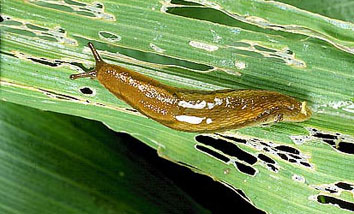Gladiolus is attacked by many insect pests. Several species of aphids like green peach aphid, potato aphid and melon aphid damage developing foliage and flowers. They can be controlled by using dimethoate. Thrips and caterpillars can be controlled with dimethoate.
Brown and Fusarium wilts are the major diseases.
Fusarial wilt
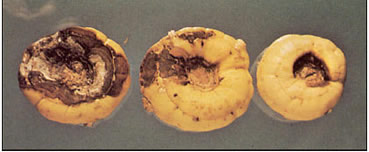
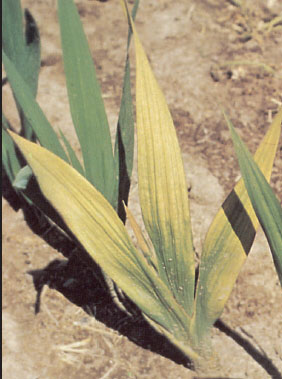
It is the most destructive fungal disease in gladiolus seen during rainy season coinciding with the months between June-October. The symptoms are a yellowing of the leaves starting with the older outside ones first and this is accompanied by the apparent stunting of newer leaves. In addition the spike itself will often be stunted and faded in colour. The plant may also have blackened areas at the base which spread onto the corm. Eventually, if left, the whole plant will wilt and when lifted for destruction, (for this is the only course of treatment), the interior of the corm when opened will appear marbled with a brown colour. Corms are completely rotten emitting foul smell.
Spraying the crop with 0.03% copper oxychloride or drenching carbendazim 0.5% is recommended when diseases are noticed.
Pests & Diseases
As plant species go, the gladiolus is relatively free of pests and diseases of epidemic proportions: however, as with all subjects it is vulnerable to certain fungi, virus and insect damage. Below is a summary of some of those that are more likely to be encountered in no particular order of their threat. The common prevention message as far as all are concerned is to destroy all infected or suspect tissue whether leaf or corm - do not compost.
|
|
|
|
Storage Rot Corms that have been damaged in some way during the harvesting operation, including damage caused by the removal of the mother corm, or have not been cured properly whilst drying can often attract a Penicillin based rot. This rot manifests itself by the appearance of a fluffy blue or green mould which grows around and over the area of the wound. Dusting corms with a fungicide will give a degree of protection, however those corms showing serious levels of deterioration should be disposed of. |
Caterpillars Caterpillars can also be a pest and when present will often attack flower buds hewing a hole through the entire bud and thus the petals held inside. In addition they may also emerge from the tips of a spike in tight buds generating further holes which will detract from the beauty of the plant. |

Scab
Scab is caused by a bacteria called Pseudomonas marginata. It appears on the corm as pale yellowish spots which turn brown as the infection worsens, this darkening of the spots is accompanied by them sinking slightly causing small craters in the corm. In severe cases there may be seepage of fluid from the crater which will stick the husks to the corm. This disease can be easily spread from corm to corm so infected corms should be disposed of by burning.
Stromatinia Rot
This corm disease is caused by a fungus called Stromatinia gladioli and is most prevalent during periods of cool wet weather and as such can be a particular problem in northern European climates. The first signs of disease are usually on the growing plant and are evident by the yellowing of leaves which eventually shrivel and die. Evidence of the disease on the corms is the appearance of reddish brown markings which are sunken and if the corm is dissected, dark markings are seen as a marbling emanating from the centre. A particular problem with this disease is that the fungus produces an over wintering particles called Sclerotia. As a result diseased corms should never be planted and as a precaution corms should always be harvested in dry conditions. If Stromatinia is suspected in growing plants that soil should not be replanted in subsequent years as the disease is capable of passing from soil to plant.
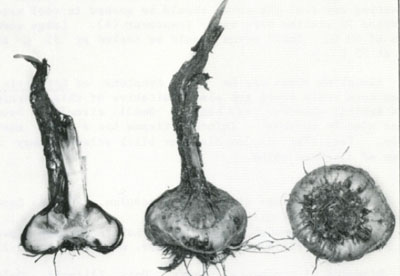
Fusarium Yellows and corm rot
This disease is caused by the fungus Fusarium oxysporum, var. gladioli and is often referred to as Fusarium yellows or Fusarium Wilt. The symptoms are a yellowing of the leaves starting with the older outside ones first and this is accompanied by the apparent stunting of newer leaves. In addition the spike itself will often be stunted and faded in colour. The plant may also have blackened areas at the base which spread onto the corm. Eventually, if left, the whole plant will wilt and when lifted for destruction, (for this is the only course of treatment), the interior of the corm when opened will appear marbled with a brown colour.
Where Fusarium occurs, fertilize sparingly: nitrogen should be applied in the nitrate form rather than as ammonia or urea. Soil pH 6.6 - 7.0 preferred. Harvest corms in dry weather if possible and cure them rapidly using forced air at 80 - 100"F if available. Inspect stored corms and rogue out suspects.
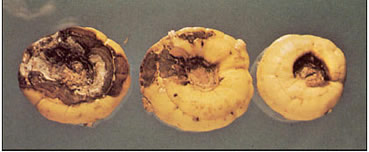
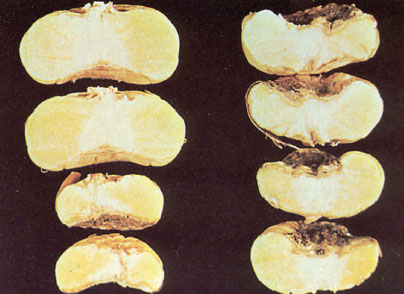

Gladiolus Rust
The Gladiolus rust, Uromyces transversalis is a disease of quarantine importance in Europe and the United States. Because it attacks mainly hybrid cultivars it would have serious consequences if it became established in greenhouses or nurseries. The sori or spore producing bodies are unusual as they develop across the width of the leaf rather than longitudinally along the veins as in most monocots.
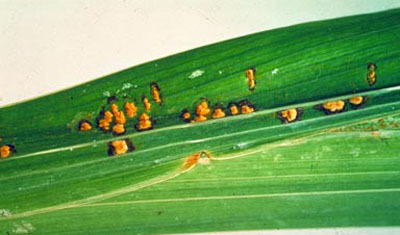
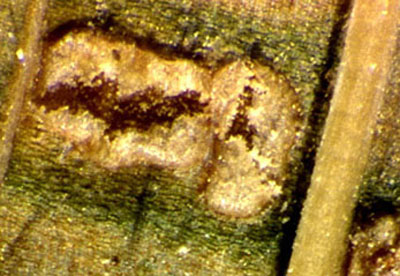
Botrytis
This disease is usually associated with the later part of the season when days are still warm but nights are cool and there is a large amount of moisture in the atmosphere. It is usually compounded by a lack of air flow around the leaves of the plant, especially evident if planted too closely together. The symptoms are small brownish spots on the leaves which often merge to form larger areas which eventually may develop into a mouldy grey growth.
Virus
There are many virus diseases which may occur resulting in mottled, streaked or spotted leaves. The effects on the florets can be patches of colour that are different from the norm ie white or purplish. In some cases, corms may also be affected becoming shrivelled.
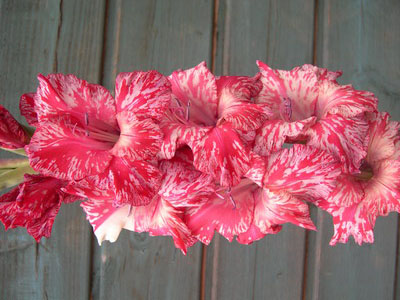
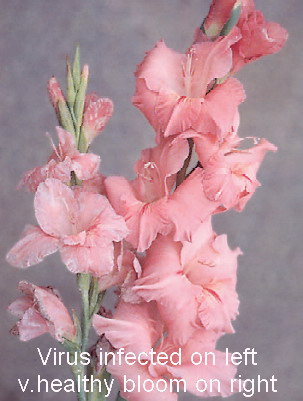
Some viruses cause cause curling of poor small spikes, small corms and poor root development. Important to destroy such plants
Thrips
The thrip is potentially the worst pest to attack gladiolus - it can also attack other garden plants. It has the ability to severely damage a whole crop. The symptoms are not usually noticed until the infestation has occurred and by this time it is usually too late to rescue the situation. The one saving grace is that the insect cannot overwinter out of doors in northern Europe and northern North America.
Plants severely infested with gladiolus thrips have a spotted, bleached appearance with silvery streaking between the leaf margins. Both leaves and petals act as a food source and will appear withered. If flower buds are seriously damaged, the flowers fail to open. The entire plant may become stunted.
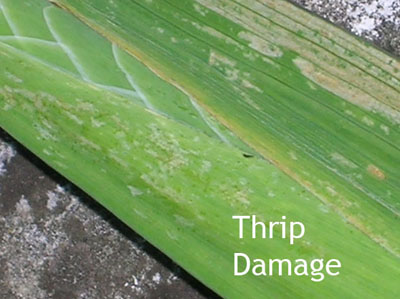

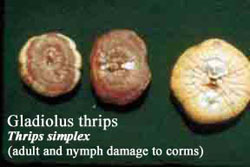
|
Gladiolus thrips are believed to be an introduced pest from Africa, where gladioli are native. The thrips are brought in from unmanaged areas in the locality of a gladiolus patch such as untended allotments, unmanaged hedges or on infested corms. These thrips can overwinter at any stage of their lifecycle on stored corms or on plants growing in greenhouses. Although the gladiolus thrips can maintain a population outside during the summer, they cannot overwinter outside in areas where the temperature consistently falls below 10° C as a result the monitoring of corms in storage is extremely important. |
|
|
The eggs are opaque, white, kidney-shaped, and about 0.34 mm long and 0.2 mm in diameter. Gladiolus thrips emerge as creamy yellow larvae, but soon turn dark brown, except for the tips of the legs which are lighter. The wings are brown above and lighter below and appear to be darker with a grey band when folded over the back. Gladiolus thrips are about 1.5 mm long and extremely slim. Males are smaller and lighter in colour than the females. The life cycle of the thrip is very much determined by the weather and in warmer conditions several generations can be produced in a short time hence the apparent sudden epidemic. |
|
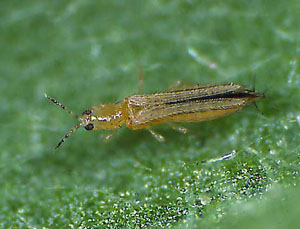
Slugs And Snails
Both slugs and snails can cause damage but in most cases it is purely cosmetic, however a severe attack to the leaves can affect the plants ability to produce a new corm for the next season. Slugs have the potential to destroy the growing shoot of a newly planted corm but once established the plant should be safe from their clutches. Snails can affect the florets and make them unsuitable for exhibition.
